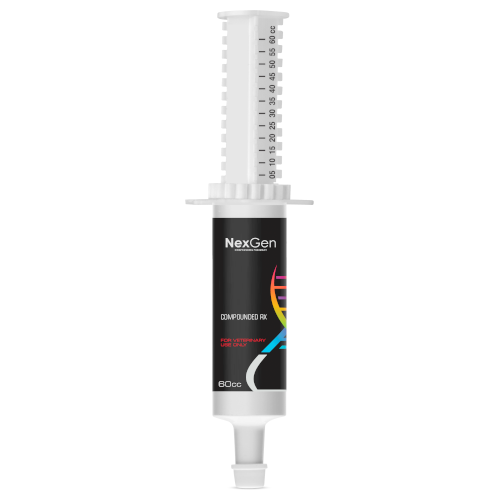
Flunixin Meglumine 50 mg/mL + Cimetidine 100 mg/mL, Oral Paste, 60mL Syringe
Login for pricing
- Brand
- Mixlab
- SKU:
- NC-0237
- Product Type:
- Paste
- Size:
- 60ml
- Administration:
- Oral
- Suggested Dosing:
- 1 ML / 100 LB
Pain management is a high priority for horse owners, managers and veterinarians caring for their equine patients. Individual pain tolerance and how a horse evidences pain may vary based factors like the horse’s age, previous experiences and environment. Some non-painful stimuli, such as anxiety and fear, may also cause similar signs as pain, making recognition of pain in horses challenging.
While a veterinarian can definitively diagnose the cause of a horse’s pain and help treat it, there are ways to get a general idea of what sort of pain a horse is suffering. Generally, it is likely that a horse is in pain if it shows one or more of these signs:
- Lameness, abnormal gait
- Unusual posture
- Shifting weight from one leg to another
- Muscle tremors
- Abnormal sweating
- Frequent periods of recumbency
- Changes in temperament
- Decreased appetite
- Abnormal reaction to grooming, saddle or bit and bridle
- Changes in feeding behavior
- Grinding teeth and/or excessive drooling
- Weight loss
- Squinting or closed eyes
- Biting or staring at a particular body region
- Evidence of injury
Types of Pain in Horses
The origins of some pain in horses can be obvious, such as rolling and kicking at the belly indicative of colic, but other signs are more subtle. Even slight injuries in the horse can give rise to inflammation. Swelling is one of the most prevalent signs of inflammation, along with heat and pain. Observation of a horse at work followed by palpation of limbs post exercise/cool-down is vital to the early detection of swelling.1 Soft tissue injuries are fairly common in horses, particularly racing Thoroughbreds, which frequently require prolonged periods of rest before being raced again. The earlier a soft tissue injury is identified, the earlier a diagnosis can be reached and the quicker a horse can get back into training.
In general, the term "colic" references abdominal pain in the horse. There are numerous causes of colic and symptoms range from very mild to violent. Colic can be caused by simple issues such as a gut spasm resulting from a change in diet, or serious ones, such as twisting of a part of the intestine. Mild colic symptoms include dullness, curling up of the top lip, adopting a “straining to urinate” stance and lying quietly.2 Different types of colic require different treatments, so an accurate diagnosis is the first step.
Gastric ulcers—also called equine gastric ulcer syndrome (EGUS)—can affect horses of any age, including foals. The literature holds that nearly 90% of racehorses and over 50% of non-performance horses suffer from this malady.3 Gastric ulcers arise when the lining of a horse’s stomach begins to become eroded due to prolonged exposure to stomach acid. There are several conditions which give rise to this; most of these are lifestyle-related. Gastric ulcers are most closely associated with athletic horses, horses under inordinate stress and horses with comorbidities (other illness).4
NOTE: The Association of Racing Commissioners International Uniform Classification Guidelines for Foreign Substances has designated cimetidine a CLASS 5 DRUG.
Where to buy Flunixin + Cimetidine
Flunixin + Cimetidine is available in the U.S. through several pharmaceutical manufacturers and through veterinary custom compounding companies.
This product carries several potential drug interactions. Please consult your veterinarian prior to beginning any treatment regimen.
FOR RX ONLY: A valid prescription from a licensed veterinarian is required for dispensing this medication.
1Knych HK, Arthur RM, McKemie DS, Baden RW, Seminoff K, Kass PH. Pharmacokinetics and anti-inflammatory effects of flunixin meglumine as a sole agent and in combination with phenylbutazone in exercised Thoroughbred horses. Equine veterinary journal. 2020.
2Long, Alicia, and Rose Nolen-Walston. Equine Inflammatory Markers in the Twenty-First Century: A Focus on Serum Amyloid A. The Veterinary clinics of North America. Equine practice vol. 36,1 (2020): 147-160.
3aaep.org.
4Merck Veterinary Manual.









